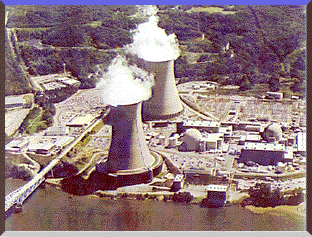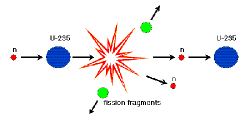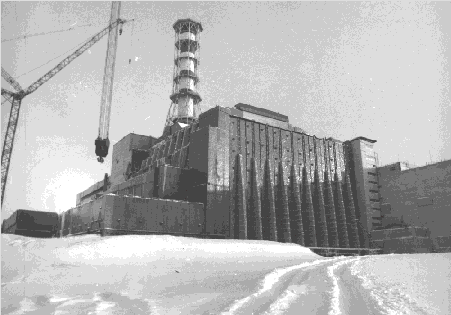
You might work hands-on with radioactive materials while working on this merit badge. It is essential that you take safety precautions before, during, and after working with any radioactive substance. Accidentally swallowing, breathing in, or coming in direct skin contact with ANY amount of radioactive material could cause severe long term health problems.
Be sure to discuss your plans for working with radioactive materials with your counselor or the laboratory manager where you obtain your samples. For safety reasons, if I am your counselor, I require that I be present whenever you work with any potentially hazardous substances.
This page is divided into three sections: meeting the requirements, further investigation, and frequently asked questions.





A. I'm glad to hear you're interested in atomic energy! I have no new information beyond what is available here; when somebody mails me an update or correction, I update this page immediately. I do not keep a list of merit badge counselors for any area; such lists should be maintained and distributed by your local Boy Scout council.
A. The simplest suggestion I've heard, courtesy of a visitor to this site, is fertilizer: "go to Lowes or Home Depot and purchase Rite-Green 808 fertilizer. If you set the Geiger Counter to the 0.1 on the 50 scale you should be able to detect the 2 microrem/hour that this type of fertilizer emits if you hold the device close enough to the open bag. This brand of fertilizer is the most radioactive type sold that I know of. I just tested this with a standard hand held Geiger Counter and it did work."
Another suggestion I've heard is to try a smoke detector. Some smoke detectors contain a small quantity of radioactive Americium; however, I haven't received confirmation of whether the alpha particles are emitted in sufficient quantity to be detected by a Geiger counter (please let me know your results if you try this). A visitor to this site notes that this technique is unlikely to work with newer smoke detectors: "the Americium-241 in smoke detectors does produce an alpha particle. However, most alpha particles can be stopped by a piece of paper, so the odds of getting a sufficient count rate using something like a Geiger counter is fairly small since the source is sealed inside the smoke detector. The isotope is extremely dangerous if inhaled or ingested, so I would never suggest disassembling the smoke detector to directly access the source."
Otherwise, my best recommendations are to contact a nuclear power plant, a university physics department, a hospital radiology clinic, or the NBC Officer (nuclear-biological-chemical) at a local military installation. They probably won't let you take any materials home (you generally have to be licensed to possess radioactive materials), but they'll likely be willing to schedule a special session to bring the Scouts in and let them work with the materials on site.
In my case, the Carnegie Mellon University physics department lent me a ceramic dinner plate that was coated with Uranium Oxide in the 1930s (yielding a beautiful orange color); this gave off enough radiation for a Geiger counter to detect. The department also lent me a geiger counter for the scouts to use.
Another possibility suggested by a visitor to this page: I collect Vaseline Glass (contains Uranium Dioxide added to the glass) and it is readily available from numerous sources, including local antique stores, the Fenton glass manufacturer and eBay. The dinner plate you acquired from Carnegie Mellon U is most likely Vaseline Glass. My pieces emit a beautiful yellow-green light under a black light, and even with a flash camera they seem to glow. I thought that it might help to know that there are more common, every day items like that dinner plate you found, which are very inexpensive, that kids should be able to find fairly easily if they know what to look for and where. For curiousity sake, here's a couple Vaseline glass references: (1) Vaseline Glass Collectors, Inc., (2) An explanation of what vaseline glass is.
Still another possibility suggested by a visitor to this page: I am a Scouter as well as a health physicist and was reading the comments on your web page, Here is a link for the least expensive check sources I have found. Remember ALARA when working with any material... Spectrum Techniques
Note that it's not a requirement to work with radioactive materials to earn the badge. If you're unable to find a sample, requirement 6 contains several options that do not require working with these materials (e.g., C, G, I, J).
A. My understanding is that although this was true for most of the 20th century, most mantles sold in the U.S. today are no longer coated with Thorium, and are instead coated with nonradioactive Yttrium. I've found a few online sites that mention this, including here and here. These are of course not rigorously scientific citations, but they back up the story I've been told about the Scouts who were disappointed to find that the new mantles they recently bought didn't register on their Geiger counter. Still, older mantles should work fine for this, but please take appropriate safety precautions when working with older mantles, especially used or brittle mantles.
A. Unfortunately, I am not familiar with any web sites with this information. You may try using the search terms "build geiger counter" in an Internet search engine. According to the 1983 merit badge pamphlet, "Instructions for building a Geiger counter are available by writing the American Nuclear Society, 555 North Kensington Avenue, La Grange Park, IL 60526, or by calling the society at 708-352-6611. A variety of types of detectors and prices are listed in the material given out by the society." Note that for requirements 6D and 6F you are not required to use a homemade geiger counter. You can use a device that you have borrowed from another source (see the previous question).
A visitor to the page suggests: I have had good luck with purchasing Civil Defense geiger counters on ebay.
A. You may be able to get a replacement badge through your local Boy Scout council office. You'll probably have to go there in person to buy one from the Scout Shop, and may need to furnish documentation proving you earned the badge. The Scoutmaster of any local troop would almost certainly be willing to help you get one, especially if you offered to counsel his or her Scouts on the badge.
A. I'm glad to hear you're running a merit badge workshop. I'm also happy that you found my site useful. Four hours sounds like enough time to work through the requirements with the boys. When I taught the merit badge in 1999 I had six hours (two three-hour sessions on consecutive Saturdays) and that was well more time than we needed. We finished the requirements early and I used the extra time to talk about chemical laboratory safety and brought in a Navy nuclear engineer to talk more about real-world reactors. My sessions had 20 Scouts in them. I would have preferred fewer (to provide the Scouts with a more individual experience) but that was the format of our workshop. Doing it on two days was useful because I assigned homework: the Scouts completed requirements 1-5 on their own and brought the results the second Saturday, then individual Scouts presented different parts of 1-5 to the group. Still, I think you'll be able to fit everything you need to do into a 4-hour session.
A. Merit badge pamphlets and other Scouting resources are now available online at http://www.scoutstuff.org. You can also find these materials at your local Boy Scout service center (check the phone directory under Boy Scouts or Scouting). Or, if you know of a troop in your area, you could probably obtain the books with their help. You should make sure you obtain the most recent edition, copyright 1983, of the Atomic Energy Merit Badge pamphlet.
A. Thanks for the information! I am happy to add contact information on this page for any organizations that work with scouts on the Atomic Energy Merit Badge.
Last modified: February 2, 2012.
This page is at http://jlg.name/scouts/atomic_energy.html